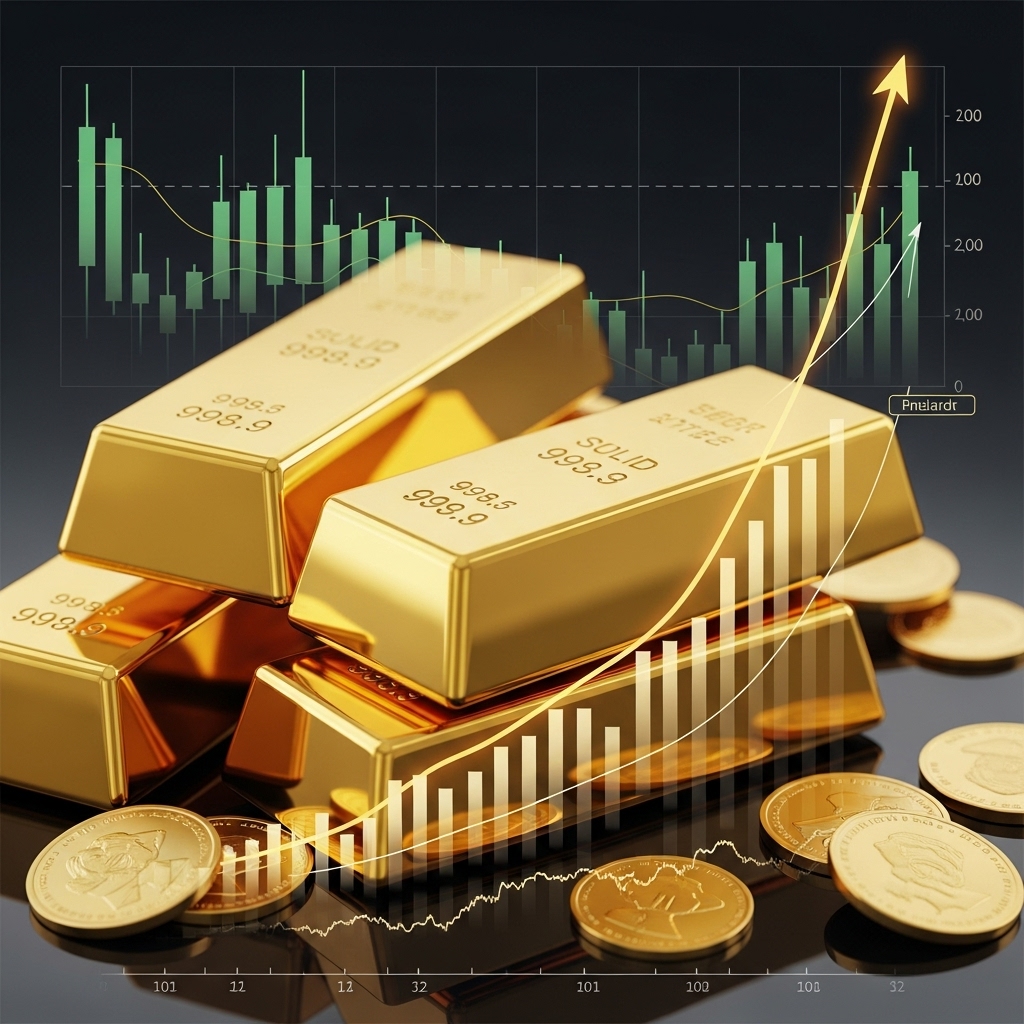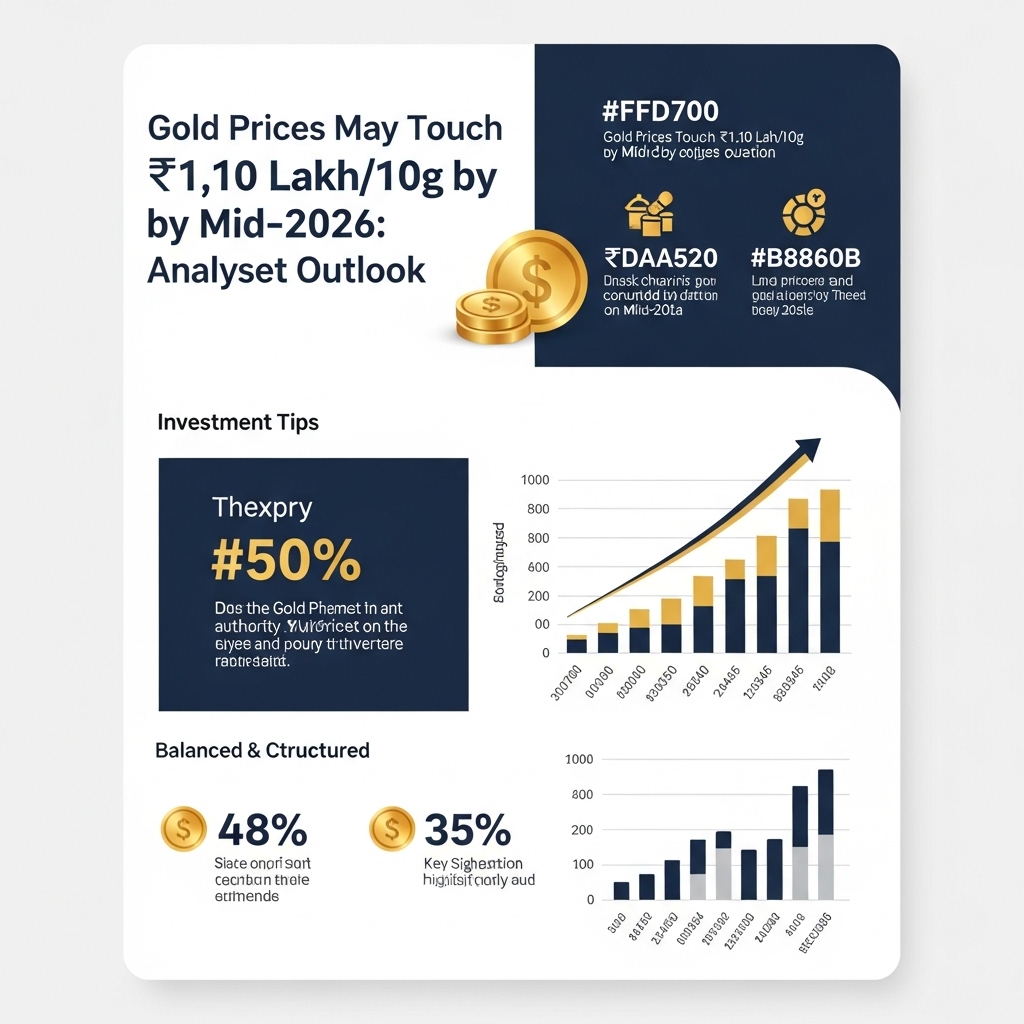Unlocking Gold’s Potential: A Look Towards ₹1.10 Lakh/10g by Mid-2026
The shimmering allure of gold has always captivated investors, but in today’s dynamic financial landscape, its gleam is brighter than ever. With global uncertainties, persistent inflationary pressures, and geopolitical shifts driving unprecedented interest, gold has firmly reaffirmed its position as a premier safe-haven asset. While recent price surges have already turned heads, what if the best is yet to come? A significant analyst outlook suggests that Indian gold prices could ascend to an astonishing ₹1.10 Lakh per 10 grams by as early as mid-2026. This isn’t just a speculative forecast; it’s a testament to powerful underlying market trends poised to redefine gold’s role in modern investment portfolios.
For astute investors, this projection presents a compelling opportunity that demands closer examination. In this blog post, we’ll delve deep into the multifaceted factors underpinning this bold prediction – from evolving central bank policies and escalating geopolitical tensions to sustained global demand and the metal’s intrinsic value as a hedge against economic volatility. Understanding these drivers is crucial for anyone looking to strategically position themselves in the precious metals market. Whether you’re a seasoned gold bug or considering your first precious metal purchase, this analysis will equip you with essential insights into the potential financial benefits and market trends that could shape your investment journey, helping you unlock gold’s potential as a powerful tool for wealth preservation and significant capital appreciation.
Gold Market Analysis and Key Insights
Current Gold Market Trends and Data
The global gold market is currently navigating a complex landscape shaped by geopolitical uncertainties, inflationary pressures, and shifting monetary policies. Spot gold prices have demonstrated remarkable resilience, often acting as a safe-haven asset during times of economic volatility. Recent data indicates a steady demand from central banks, who continue to diversify their reserves with gold. Furthermore, retail investment in physical gold, particularly in Asian markets, remains robust, driven by cultural significance and a desire for wealth preservation. While the price has seen fluctuations, the underlying trend suggests a gradual upward trajectory, as evidenced by its performance against major fiat currencies.
Investment Benefits and Considerations
Investing in gold offers several key benefits, chief among them being its role as a hedge against inflation and currency depreciation. Historically, gold has maintained its purchasing power over the long term, making it an attractive asset for wealth preservation. Its low correlation with other asset classes, such as stocks and bonds, provides valuable portfolio diversification. However, investors must also consider potential drawbacks. Gold is a non-yielding asset, meaning it does not generate regular income like dividends or interest. Its price can be volatile in the short term, influenced by factors like interest rate hikes, which can increase the opportunity cost of holding gold.
Expert Recommendations
Analysts forecasting a potential rise to ₹1.10 lakh per 10 grams by mid-2026 suggest several strategic approaches for investors. The consensus among many experts is to maintain a strategic allocation to gold within a diversified portfolio. This approach allows investors to benefit from gold’s safe-haven properties without over-exposing themselves to its potential short-term volatility. Many recommend a staggered investment approach, buying gold at different price points to average out the purchase cost. For those looking for growth potential, considering gold-backed ETFs or mutual funds can offer liquidity and ease of trading compared to physical gold. A long-term perspective is crucial, aligning with the forecast of substantial price appreciation.

Gold Investment Strategies and Options
Given the bullish outlook, investors can consider various avenues to capitalize on the anticipated rise in gold prices. Physical gold (coins, bars, jewelry), while offering tangible ownership, comes with storage and purity concerns, and higher transaction costs like making charges for jewelry, often making it less ideal for pure investment. For a more liquid, transparent, and cost-effective approach, Gold Exchange Traded Funds (ETFs) are popular, allowing investors to buy and sell gold units on stock exchanges without physical storage hassles.
A robust government-backed option is Sovereign Gold Bonds (SGBs), which offer guaranteed interest income (currently 2.5% p.a.) on top of capital appreciation, along with exemption from capital gains tax upon maturity. While less liquid due to an 8-year lock-in period (with exit options after 5 years), they completely eliminate storage and purity concerns. Investors seeking professional management and broader exposure can opt for Gold Mutual Funds, which invest in gold ETFs or companies involved in gold mining. Newer options like Digital Gold offer convenience for small-ticket investments, though their regulatory framework is still evolving and varies across platforms.
Risk assessment and portfolio allocation are crucial. Gold typically acts as a safe-haven asset and a hedge against inflation and economic uncertainty, thus diversifying a portfolio. A common allocation ranges from 5-15% of one’s total portfolio, depending on individual risk tolerance, market conditions, and overall financial goals. Investors should remember that while gold tends to perform well during economic downturns, its prices can still experience short-term volatility.
Comparing methods, SGBs offer tax efficiency and fixed income, ETFs provide liquidity and price transparency for active traders, while physical gold satisfies a desire for direct ownership. Market timing in gold can be challenging despite the long-term forecast. Prices are influenced by global interest rate movements, the strength of the US dollar, geopolitical events, and central bank policies. Employing a dollar-cost averaging strategy by investing fixed amounts regularly can help mitigate the impact of short-term price volatility and build a position over time, aligning well with a multi-year bullish forecast. This systematic approach can average out purchase costs and reduce the risk of buying at peak prices.
Market Performance and Outlook
Gold has demonstrated robust historical performance, consistently acting as a store of value and a hedge against inflation and economic uncertainty. Over the past decade, prices have shown a generally upward trend, punctuated by periods of volatility influenced by global events. Currently, the market is navigating a complex environment. While inflation has been a supportive factor, rising interest rates in major economies are creating headwinds, potentially making non-yielding assets like gold less attractive. Geopolitical tensions and persistent global economic uncertainties, however, continue to lend support to gold’s safe-haven appeal.
Looking ahead, an analyst outlook suggests gold prices could reach ₹1.10 lakh per 10 grams by mid-2026. This prediction is underpinned by several key economic factors. Firstly, expectations of potential interest rate cuts by central banks in the latter half of 2025 or early 2026 could reduce the opportunity cost of holding gold. Secondly, ongoing geopolitical instability and the possibility of further economic slowdowns in key regions are likely to sustain demand for safe-haven assets. Additionally, continued central bank gold purchases and robust demand from emerging markets, particularly India and China, are anticipated to provide a strong floor for prices. The rupee’s trajectory against the dollar will also play a crucial role in the domestic price of gold.
Frequently Asked Questions About Gold Investment
What factors are driving the analyst’s projection of ₹1.10 Lakh/10g by Mid-2026?
The forecast typically considers global economic uncertainties, ongoing geopolitical tensions, persistent inflation concerns, robust central bank gold purchases, and a potential weakening of the US dollar. Gold often acts as a safe-haven asset during such periods, attracting investor demand.
Is this price prediction guaranteed, or are there uncertainties?
It’s crucial to understand that this is an analyst’s outlook, not a guarantee. Price predictions are based on current trends and assumptions, which can change. Market volatility, unforeseen global events, or significant shifts in economic and monetary policy could impact the actual price trajectory.
How can investors gain exposure to gold in India?
Investors have several options: buying physical gold (jewelry, coins, bars), investing in Gold Exchange Traded Funds (ETFs), purchasing Sovereign Gold Bonds (SGBs) issued by the government (which offer additional interest), or through Gold Mutual Funds that invest in gold-related assets.
What are the main risks associated with gold investment?
Key risks include price volatility, lack of income generation (unlike dividends from stocks or interest from bonds, with SGBs being an exception), liquidity issues with large physical gold holdings, and the costs and security concerns associated with storing physical gold.
Should I invest in gold now, given this positive outlook?
Investment decisions should align with your personal financial goals, risk appetite, and overall portfolio diversification strategy. While the outlook is positive, consider your investment horizon and consult with a qualified financial advisor to determine if it fits your individual investment plan.

Final Thoughts on Gold Investment
The compelling analyst outlook, projecting gold prices to potentially reach ₹1.10 Lakh/10g by mid-2026, highlights a significant upside for investors. This reinforces gold’s enduring role as a critical safe haven, a potent inflation hedge, and a vital portfolio diversifier, particularly amidst current economic uncertainties. For those seeking to preserve and grow wealth, gold’s historical resilience and future potential make it an exceptionally attractive asset.
Considering these insights, now appears to be an opportune moment to strategically integrate gold into your investment portfolio. Whether through physical gold, ETFs, or other avenues, a thoughtful allocation can fortify your financial future. We strongly encourage you to consult with a qualified financial advisor to develop a personalized strategy that aligns with your unique investment goals and risk tolerance. Don’t miss the chance to potentially capitalize on gold’s gleaming trajectory.